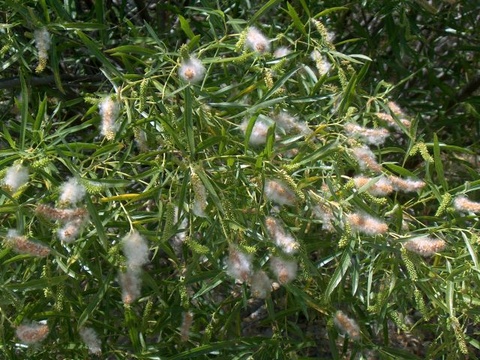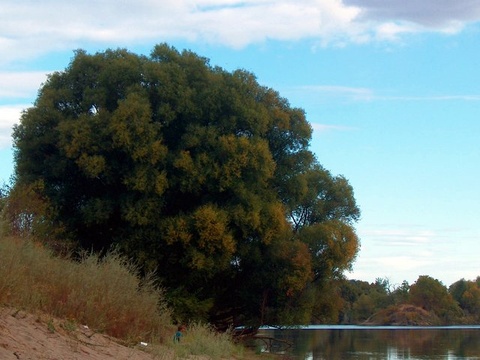Willows are winter-deciduous trees or large shrubs in the Salix genus of the willow family that usually grow in riparian forest. Many of them are native to the Yuba-Sutter area. Their leaves are a favorite food for the caterpillars of the Lorquin's admiral, mourning cloak, Western tiger swallowtail, and green comma butterflies, all of which are also native to the Yuba-Sutter area. In addition, native birds such as lesser goldfinches, acorn woodpeckers, and white-crowned sparrows frequently use willows for food or shelter.
Donna M. Landerman's column "A Drug Store in the Maidu's Back Yard," printed in the Territorial Dispatch on November 11, 2009, explains some of the many uses of willows:
| Willow or Che'-pum du and Koo'-ne. The fact that willows have several Nisenan names indicates Nisenan recognized [sic*] several species of willow. It was such a useful plant it must have received their close attention. The flexibility of its branches and shoots made it especially useful as a construction material, as the framework for dome-shaped tule houses, for example. Whole, shaped, or split willow rods were especially useful in weaving baskets. Roughly constructed burden baskets and fish traps, as well as the finest baskets, were woven on willow foundations. |
|
Throughout the ages the medicinal powers of willows have been recognized as a cure or nearly every ailment you can think of, including indigestion, worms, diarrhea, dysentery, cuts, bruises and even to prevent tooth decay. Willow was widely used by Native Americans as a headache cure. Sure enough, it contains the ingredient "salicin" which, when ingested, breaks down into salicylic acid, the main constituent of aspirin, the modern world's most common cure or headache pain and minor inflammations. |
|
*[It is important for us to recognize that the Nisenan still exist. It is rude to speak of them as if they don't.] |
Frémont's cottonwood trees (named for John C. Frémont) are members of the willow family but are not actual willows. They are 60- to 90-foot-tall trees, much bigger than any of the native willows. They do not need as much water as willows, so although they often grow among willows in riparian forest, they are also common in central oak woodland, valley grassland, and yellow pine forest. Frémont's cottonwood trees can be found in virtually every corner of both Yuba and Sutter Counties.
Shining Willow
Shining willow is a 13-foot-tall shrub or small tree that is native to Yuba and Sutter Counties and typically grows at elevations below 8,500 feet. It is found in riparian forest. It prefers sun or partial shade.
You can read more about it at USDA Conservation Plant Characteristics. You can see pictures of it at CalPhotos, Flickr, and Picasa. You can find out where to buy it at the California Native Plant Link Exchange.
Arroyo Willow
Arroyo willow is a 10- to 35-foot-tall by 5- to 10-foot-wide shrub or small tree that is native to Yuba and Sutter Counties and typically grows at elevations below 7,000 feet. It is most often found in marshes and wet meadows in riparian forest. It prefers full sun. Botanist Amos Arthur Heller collected samples of arroyo willows in 1905 at what is now the intersection of Ramirez Street and East 13th Street in Marysville.1
You can read more about it at the Theodore Payne Wiki and the Las Pilitas Nursery website and USDA Conservation Plant Characteristics. You can see pictures of it at CalPhotos, Flickr, and Picasa. You can find out where to buy it at the California Native Plant Link Exchange.
Sandbar Willow
 A female sandbar willow (Salix exigua) sheds its seeds into the Yuba River in Timbuctoo. Photo by queerbychoice. Sandbar willow (also called narrowleaf willow) is a 10- to 12-foot-tall shrub or small tree that is native to Yuba and Sutter Counties and typically grows at elevations below 5,000 feet. It is most often found in marshes and wet ditches in riparian forest. It prefers sun or partial shade.
A female sandbar willow (Salix exigua) sheds its seeds into the Yuba River in Timbuctoo. Photo by queerbychoice. Sandbar willow (also called narrowleaf willow) is a 10- to 12-foot-tall shrub or small tree that is native to Yuba and Sutter Counties and typically grows at elevations below 5,000 feet. It is most often found in marshes and wet ditches in riparian forest. It prefers sun or partial shade.
You can read more about it at the Theodore Payne Wiki, the Las Pilitas Nursery website and USDA Conservation Plant Characteristics. You can see pictures of it at CalPhotos, Flickr, and Picasa. You can find out where to buy it at the California Native Plant Link Exchange.
Red Willow
Red willow (also called polished willow) is a 25- to 40-foot tall by 25-foot-wide tree that is native to Yuba and Sutter Counties and typically grows at elevations below 5,000 feet. It is most often found in wet ditches in riparian forest.
You can read more about it at the Theodore Payne Wiki and the Las Pilitas Nursery website. You can see pictures of it at CalPhotos, Flickr, and Picasa. You can find out where to buy it at the California Native Plant Link Exchange.
San Joaquin Black Willow
 San Joaquin black willow (Salix gooddingii) on the Feather River in Beckwourth Riverfront Park Complex. Photo by queerbychoice. San Joaquin black willow can be seen in Beckwourth Riverfront Park Complex. It is a 30-foot-tall by 30-foot wide tree that is native to Yuba and Sutter Counties and typically grows at elevations below 2,000 feet. It is most often found in marshes and wet meadows in riparian forest.
San Joaquin black willow (Salix gooddingii) on the Feather River in Beckwourth Riverfront Park Complex. Photo by queerbychoice. San Joaquin black willow can be seen in Beckwourth Riverfront Park Complex. It is a 30-foot-tall by 30-foot wide tree that is native to Yuba and Sutter Counties and typically grows at elevations below 2,000 feet. It is most often found in marshes and wet meadows in riparian forest.
You can read more about it at the Theodore Payne Wiki and the Las Pilitas Nursery website. You can see pictures of it at CalPhotos, Flickr, and Picasa. You can find out where to buy it at the California Native Plant Link Exchange.
Pacific Willow
Pacific willow is a 10- to 30-foot-tall shrub or small tree that is native to Yuba and Sutter Counties. It is found in riparian forest.
You can read more about it at the Theodore Payne Wiki andthe Las Pilitas Nursery website. You can see pictures of it at CalPhotos, Flickr, and Picasa. You can find out where to buy it at the California Native Plant Link Exchange.
Dusky Willow
Dusky willow is a 12-foot-tall shrub or small tree that is native to Yuba County and typically grows at elevations below 8,000 feet. It is found in riparian forest.
You can read more about it at the Las Pilitas Nursery website. You can see pictures of it at CalPhotos, Flickr, and Picasa. You can find out where to buy it at the California Native Plant Link Exchange.
MacKenzie's Willow
MacKenzie's willow is a shrub or small tree that is native to Yuba County and typically grows at elevations below 7,000 feet. It is found in riparian forest.
You can see pictures of it at CalPhotos, Flickr, and Picasa. You can find out where to buy it at the California Native Plant Link Exchange.


